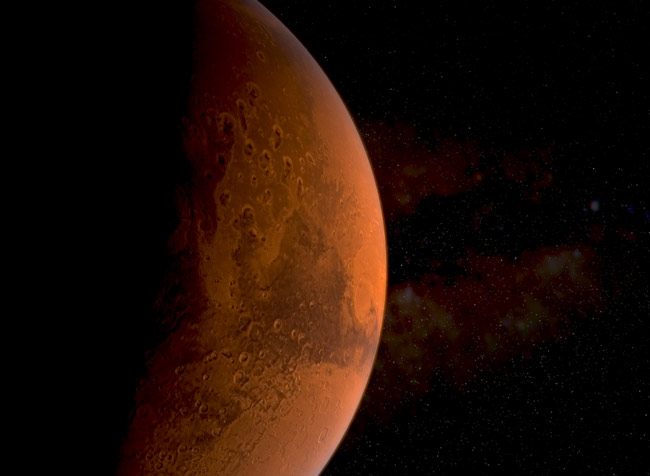NASA’s Mars Rovers to Hit the Silver Screen

NASA'shardy twin robots Spirit and Opportunity currently roving across the surface ofMars will be immortalized in a fresh documentary about their wildly successfulmission.
Disney'snew IMAX film Roving Mars,set to open nationwide on Jan. 27, chronicles the exploits of NASA's Mars Exploration Rover (MER) missionthat entered its third year exploring the surface of the red planet this month.Originally slated for a 90-Martian day mission, Spirit and Opportunity haveconsistently surpassed the expectations of their handlers and filmmakersthroughout their mission.
"Myoriginal idea was to wait for the rovers to die and that it would be a dramaticending," Roving Mars director George Butler told SPACE.com. "However,these rovers won't die,which is excellent news."
On Mars,Spirit is slowly making its way toward a rock target dubbed "Home Plate" at itsGusev Crater landing site. Its robotic twin Opportunity, meanwhile, isexploring a crater named Erebus on the plains of Meridiani Planum. While thestars of Roving Mars are the rovers themselves, the film includescomments rover scientists such as Steve Squyres, the mission's leader atCornell University.
"During thelandings, particularly, you really relive it," Squyres told SPACE.com ofthe film. "The tension and the drama, it is all there."
With amission that has lasted beyond all predictions, Squyres said he and his scienceteam are worn but holding together. The recent addition of several new science teammembers has eased the extended mission's strain, allowing mission managers tofocus on Spirit's trip toward a rock target dubbed 'Home Plate' whileOpportunity prepares for its first drive in weeks,he added.
"Thebiggest challenge was being patient while things were going on on Mars," Butlersaid. "When you make a documentary like this, you never know what's going tohappen. I think it's an epic story."
Breaking space news, the latest updates on rocket launches, skywatching events and more!
Butler,whose bodybuilding film Pumping Iron made Arnold Schwarzenegger ahousehold name, said the rovers' abilities - specifically their high-resolutionpanoramic cameras - were the lynchpin that made the 100-minute RovingMars ?possible.
"That, tome, was the determining factor," Butler said. "Honestly, I was not reallyinterested until I heard these rovers were equipped with IMAX quality cameras.Then I thought, 'Wow, if I could put Mars on an IMAX screen that would begreat.'"
ForSquyres, Roving Mars is a vindication of sorts for the engineers behindthe panoramic cameras, or PanCams, aboard Spirit and Mars.
"We've beensaying for years that the PanCam images were good enough to look good on anIMAX screen and by God they do," Squyres said, adding that he and his team havenot been able to view rover imagery at its full potential until now. "Acomputer screen falls woefully short. It's like looking through a soda straw."
Butler'steam relied on actual data and images beamed back to Earth from Spirit andOpportunity, as well as the computer imagery talents of Ithaca, New York-basedMaas Digital, which created original animations for NASA to illustrate therover mission.
"The majordifference is that when we did the earlieranimation, it was before the rovers had landed on Mars," said the Dan Maas,of Maas Digital, in a telephone interview. "Whereas with this film...we have muchmore of a historical recreation of exactly what the rovers saw."
Depictionsof the rover landings, during which they plunged through the Martianatmosphere, deployed parachutes then bounced along the red planet's surfacewith airbags, are based on data from gyroscopes and accelerometers embedded inthe landing craft, Squyres said.
Filmmakers alsooverlaid digital elevation models recorded by Spirit and Opportunity with roverimagery to generate accurate landscapes for their computer-generatedcounterparts to explore, travels that again are based on mission telemetry, headded.
Piecingtogether rover images into a seamless vista for the IMAX screen sometimes tookweeks at a time, Maas said, adding that while the film is aimed at adults andchildren alike, devoted rover fans will find gems like 'Adirondack,''Sushi'and 'Sashimi'- the first rock targets approached by the rovers -and others peppered in theshow.
"I thinkthat Mars is the most accessible planet beyond Earth," Maas said, explainingthat the red world has a special place in the hearts of young and old alike."It's one of the handful of places in the Solar System where we have the chanceof finding traces of current or past life. I think it's a foregone conclusionthat the next world for humans will be Mars."
- 'Pumping Iron' Director Spotlights Mars Mission in IMAX Film
- Complete Coverage: Spirit and Opportunity's Mission to Mars

Tariq is the award-winning Editor-in-Chief of Space.com and joined the team in 2001. He covers human spaceflight, as well as skywatching and entertainment. He became Space.com's Editor-in-Chief in 2019. Before joining Space.com, Tariq was a staff reporter for The Los Angeles Times covering education and city beats in La Habra, Fullerton and Huntington Beach. He's a recipient of the 2022 Harry Kolcum Award for excellence in space reporting and the 2025 Space Pioneer Award from the National Space Society. He is an Eagle Scout and Space Camp alum with journalism degrees from the USC and NYU. You can find Tariq at Space.com and as the co-host to the This Week In Space podcast on the TWiT network. To see his latest project, you can follow Tariq on Twitter @tariqjmalik.
